 August 5, 2008
August 5, 2008
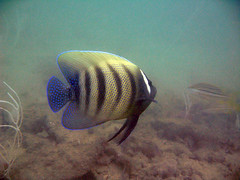
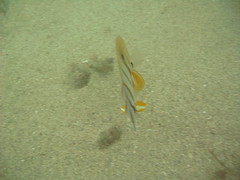
It’s been awhile since you took a look at underwater Hantu! I hope the pictures this dive satiate your cravings! But before all that… a weather report! It’s the middle of the year and when we should be expecting hot and dry days, many of you on this island Republic will realise that it’s been anything but. Scattered showers and storms have been dotting the week, and it looks like the tend is going to keep up till the monsoon season. With it raining throughout the year, you wonder if the “monsoon season” needs a new definition. Despite the ominous weather, lucky us, we had sunshine all day. I even managed to get a little bit roasted. (Not that I had the intention) ABOVE: Six banded Angelfish, Copper banded Butterflyfish
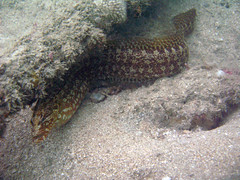
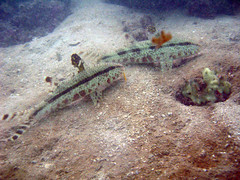
And what better way to compliment a sunny day than with great vis at Hantu! If you couldn’t join us this weekend, you missed a pretty lot! Regular divers of Hantu appreciate a day of good vis, and newcomers to the waters wonder what all the hype is about. More than anything, improved vis simply means diving with a little more comfort, there’s no greater or less luck with finding critters. ABOVE: Carpet eel blenny, Speckled goatfish
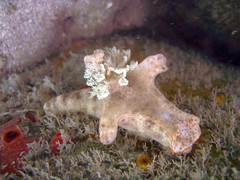
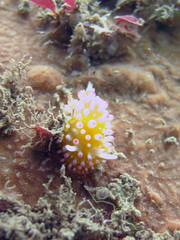
I managed to spot myself an elusive though relatively well known critter of local waters, the Ceratosoma nudibranch with its winglike appendages. But what bewildered me more was this yellow little sea slug, covered with spectacular white knobs with pink tips. This was one thing I’d never seen before. If you can tell by the size of the algae in the same shot, this critter was tiny. So it was tough getting a good shot of it though there is another view of it in our Gallery.

Taking advantage of the decent vis, I took this wideshot of the silver moonies. They are surreal to watch and often school in the waters of Hantu. They are skittish and can disappear very quickly when there’s too much activity in the water. They also like to keep shallow, which ironically leads to them often being missed because divers like to look down into the depths!

But the truth is, there are some good things to see in the deep depths. Especially if you bother to squint really hard. Like this Whip coral goby. Marvelous creatures.

Blue spotted fantail rays are often found hiding under some crevice during the day time, because they’re actually nocturnal. During daylight they hide and rest, and at night they’re our in full force, hunting for a meal. I actually spotted this ray sleeping next to a very unassuming neighbour…
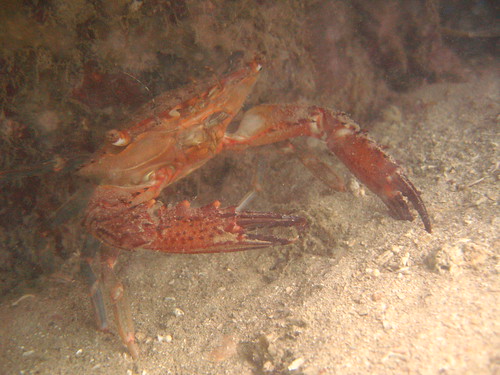
A surprisingly laid back Red swimmer crab rests in a crevice next to the ray. These crabs are also more active at night. Anyone who’s seen a Red swimmer crab on the offense will be able to tell how unprovoked this individual is.
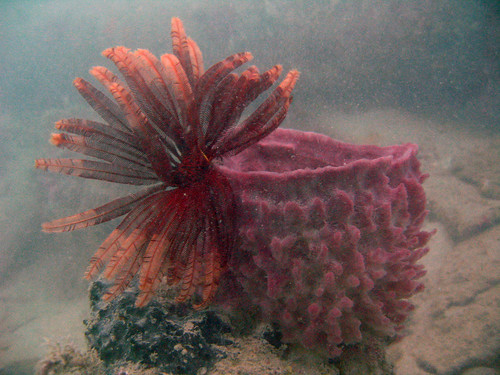
There were PLENTY of crinoids out at Hantu. Someone should really look into why most of the crinoids in Hantu are predominantly red or reddish. We’ve seen some green, yellow and white ones, but most often we come across the red ones.
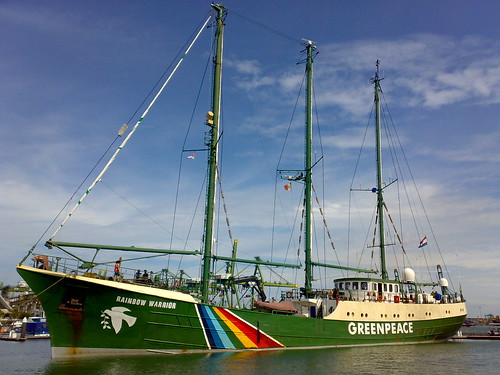
On the way back to mainland, we were so excited to see the mighty Rainbow Warrior berthed at the marina. This ship has traveled across all the world’s oceans and is an ambassador for peace not only towards the environment but towards humanity. It was very inspiring to finally behold this great ship.
 Posted in Blog Log
Posted in Blog Log  No Comments »
No Comments »
 August 4, 2008
August 4, 2008
Join us for a fun filled celebration of the International Year of the Reef (IYOR) 2008 on Friday 8 August 2008, from 4-7pm at Function Hall, Botany Centre of the Singapore Botanic Gardens!IYOR 2008 is celebrated worldwide to raise awareness about the importance of coral reefs and threats to their sustainability, and to motivate people to take action to protect them.
Comprised of a diverse group of individuals and organizations active in marine conservation who have come together for a common cause, the Singapore IYOR working committee is proud to present this official launch, which aims to showcase the array of events and activities that have taken place and are lined up for the rest of the year for everyone’s participation to make a difference for the reefs.
Chairman of the IYOR Singapore Committee, Mr Francis Lee, shall also represent the members to receive a $5000 donation from TMX, organizer for the Asian Dive Expo (ADEX) this year at Suntec City, raised to support the committee’s conservation efforts.
Gracing the occasion, are Prof Tommy Koh and Prof Chou Loke Meng from the National University of Singapore, who shall each provide a keynote address all attendees on their personal thoughts on the importance of reef conservation and to call for more public support for this meaningful cause.
Please see IYOR invite for more information.
We look forward to seeing you!
 Posted in Announcements, Events
Posted in Announcements, Events  No Comments »
No Comments »
 July 28, 2008
July 28, 2008
We’re experiencing some problems with our WordPress and Flickr network, so here’s the short of it. They say a picture paints a thousand words, so take a peek into our gallery for a looksee at what we were lucky enough to experience today at Hantu! The rant will come along later, after we sort out this techy issue! The wait will be worth it! Stay tuned!
 Posted in Blog Log
Posted in Blog Log  No Comments »
No Comments »
 June 30, 2008
June 30, 2008
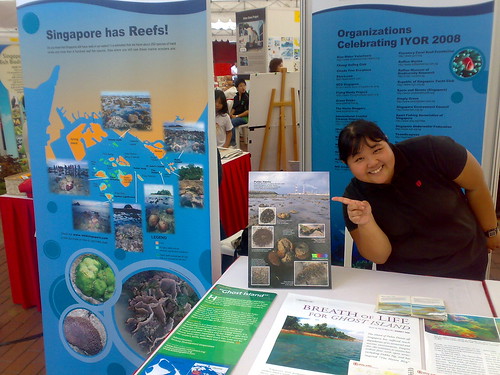
The Hantu Blog spent the weekend at Envirofest 2008, amidst a wholesome selection of all sorts of environmental groups like the Naked Hermit Crabs, Nature Society of Singapore, and Raffles Museum Toddycats. Holding an event such as this in the heartlands of Toa Payoh was very refreshing! We met all sorts of interesting individuals along with some very promising young people who hopefully will remember the wonderful things they learnt about Singapore waters when the grow up!
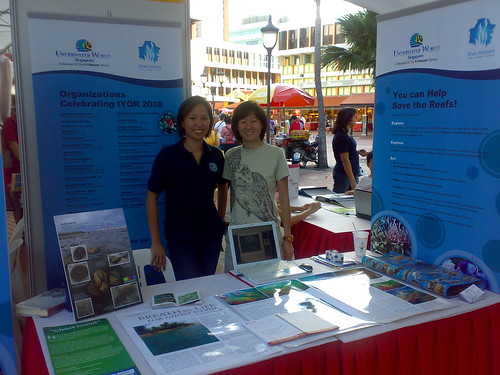
Volunteers Hui Bing and Chay Hoon gave their precious time to our humble booth at Envirofest’08. It was tough competing with the throngs of people that flocked to the Toddycat booth to view and learn about about the amazing specimens on display!
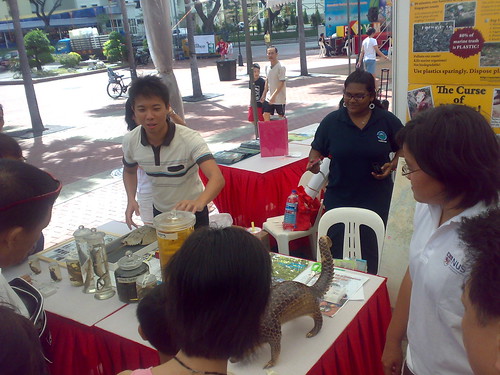
Chay Hoon also gave a talk at the event on Sunday and educated some kids about the variety of creatures that can be spotted in Singapore.
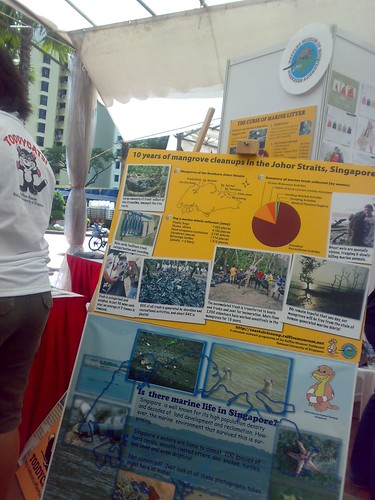
Amongst the animal exhibits, the Toddycats had a host of interesting displays that where so chock full of knowledge that even I learned something new! Some of Singapore’s most experience nature people like Oi Yee were also present at the booth to literally blow people’s minds away with loads and loads of information on local fauna, flora and ecology!
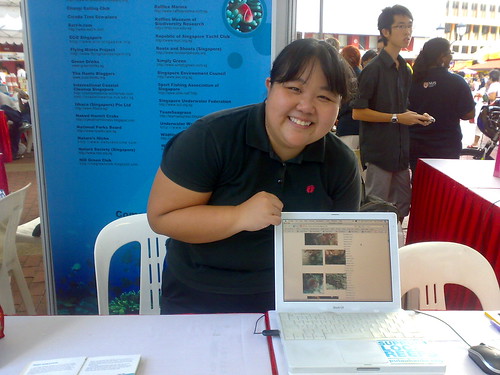
And Siva played the role model by showing everyone you can help make a difference to the environment in your own little way such as riding your bike instead of relying on fuel dependent vehicles!
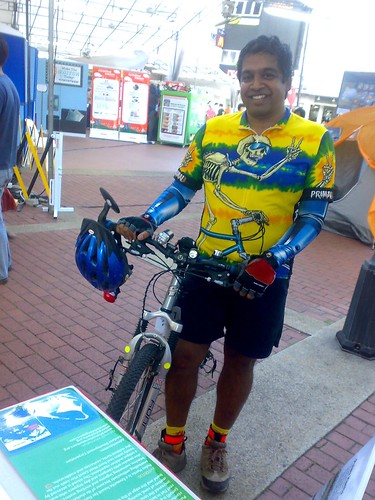
You can read more about event at Habitatnews . Wildfilms also blogged about the event and took heaps of pictures! We also managed to organise a dive at Hantu over the same weekend so we’ve been really busy! Stay tuned to read the trip report from our dive and view more awesome pictures!
 Posted in Events
Posted in Events  No Comments »
No Comments »
 June 25, 2008
June 25, 2008

Where: Toa Payoh Amphitheatre (In front of Toa Payoh Community Library)
When: 11:00AM – 8:00PM Saturday, June 28th & 29th
What: The Hantu Blog will have a booth at Envirofest’08. Come down to meet our volunteers and get first hand accounts of what it is like to dive in Singapore waters! We’ll be there to answer all your questions about what you can expect to encounter in local waters, and give you tips about what you can do in your everyday life, in your school, or at work, to help protect our very unique Singaporean environment Bring your friends along too!
The event is expected to draw a crowd of some 5,000 – 6,000 visitors.
The other nature and environment groups will be there as well, including the Naked Hermit Crabs, Toddycats, NParks and Waterways Watch as well as the Animal Welfare groups. So you can catch up and get to know some similarly passionate friends from the community!

When: 2:30PM – 3:00PM Sunday, June 29th
What: Hantu Blog diver, reef volunteer, and nudibranch enthusiast, Chay Hoon, will be giving a talk to share her experiences and knowledge of the local seas with the audience at Toa Payoh HUB on Sunday!
She will showcase her photos gathered from her tireless hours and days spent on reef walks and diving! Chay Hoon has amongst her collection species that have only recently been recorded in local archives so come down and be one of the first few Singaporeans to see some of the amazing creatures that share our waters with us!
Chay Hoon is among the most dedicated and regular guides at Chek Jawa, a volunteer with Beach Fleas, as well as a volunteer crew member with WildFilms.
 Posted in Events
Posted in Events  1 Comment »
1 Comment »
 June 23, 2008
June 23, 2008
We’re not used to seeing huge heaps of trash piled up high in spanking-clean Singapore. Most of us have no idea where our garbage goes. Because we don’t actually take out the trash (if we live in apartments most of us have a private chute) and the garbage collectors come practically everyday, it’s difficult to understand the phenomenal amount of trash each of us consumes on a daily basis, and then, in a lifetime.
In Singapore we don’t have dump sites, which are highly unsightly. While there are some dump yards for specific types of waste like construction waste and waste metal, they are isolated at the very corners of our little island, hidden from the discriminate eyes of residents and tourists. It almost seems a miracle that a country so densely populated and with such little land can find a solution to its growing amounts of waste.
So where does all the trash go in land-scarce Singapore. In the sea of course. But it’s very well managed. State of the art seawalls keep the incinerated and processed trash (the garbage isn’t dumped as it is) inside the oceanic landfill. It also keeps the ocean out, which is very important.
But our resources are finite. There’s only so much ocean and land we can fill. However, our appetite for consumption is limitless. On average, products are disposed within six months of their purchase. We have to invent more, and new ingenious ways of looking after our trash. Because if you ignore your trash, it’s going to come back and haunt you.
This article, first featured in The Ecologist magazine discusses how “Old plastic rubbish doesn’t die it just gets tossed away in far-off places that we rarely get to see. Daisy Dumas assesses its impact on the world’s largest floating landfill the Great Pacific Garbage Patch.”
 Posted in News
Posted in News  No Comments »
No Comments »
 June 3, 2008
June 3, 2008
27 May 2008
Scientists have discovered a vast new underwater colony labelled ‘Brittlestar City’ south of New Zealand.
Millions of starfish-like creatures have been found on a peak 90 metres below the sea surface on the subsea Macquarie Ridge stretching 1,400km south of New Zealand. Details of the major find were announced by the National Institute of Water and Atmospheric Research at a biodiversity conference in Oslo.
They dubbed the peak, filmed with a robot submarine, Brittlestar City after the five-armed creatures related to starfish, sea cucumbers, sea lilies, and sea urchins.
Tens of millions live arm tip to arm tip in a swirling circumpolar current flowing over and around it at roughly four kilometers per hour.
It allows Brittlestar City’s life to capture passing food simply by raising their arms, and it sweeps away fish and other hovering would-be predators.
Marine mission
Discovery of this marine metropolis highlighted a month-long expedition to survey the Macquarie Ridge aboard the NIWA’s research ship Tangaroa.
Scientists photographed brown-black brittlestars numbering hundreds per square meter and estimate tens of millions of them populate the 100 square km flat top of the seamount.
“We were excited to see such a huge assemblage of brittlestars on the Macquarie Ridge seamount,” said NIWA ecologist Ashley Rowden.
“Not only is it amazing to see a vast array of one type of organism but the implications of the find for our understanding of the relative uniqueness of seamount assemblages are potentially far-reaching.”.
New and rare species
The eight biologists on board believe some species collected have never before been recorded in the region while some may be new to science.
An abundance of deepwater cardinal fishes was found sheltering below a rock ledge on the seamount. In the lee of the rock, biologists believe, the fish could both conserve energy and access food.
Cod were found in the folds of a large bubblegum coral (nearly two meters high, and likely hundreds of years old). These fish were also believed to be finding shelter from the current and perhaps benefiting in other ways from their close association with the coral.
Rowden said aggregations like this had never before been observed.
“It’s this sort of information will allow us to improve our knowledge of biodiversity in the deep sea, and how best to manage it,” said Rowden.
 Posted in Biology, News
Posted in Biology, News  No Comments »
No Comments »
 May 25, 2008
May 25, 2008

Despite the days of rain and even the morning shower, we had uber fantastic weather and an appropriately comfortable day of average visibility diving. Storm clouds rolled in during the later part of the day but swept across Pulau Senang and left us rain free though it did bring the vis down deep a little lower. But of course, we still had an incredible day diving.






Though common on the reef, flabellinas continue to thrill divers with their electrifying colours. The reefs around Pulau Hantu are well known for their nudibranch diversity. Today, a new species was photographed by one of our diver guides Marcel den Herder. Once I get my fins on it, I’ll be sure to post it right here so you gawk at it. Star tuned.
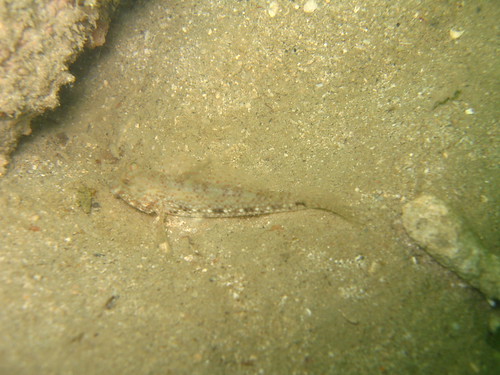
Not usually easy to photograph are these tinsy tiny gobies. The sand coloured fish are extremely skittish and sometimes can be found sharing a burrow with a blind shrimp. Oddly enough, this one seemed stoned and unfazed by my presence so I had to reward it by posting it’s picture online for all to see. There are several species of gobies found in and around Hantu island. Not all have been documented. They can be found living in coral, the reef and the sand or rock crevices. Gobies are possibly the most species diverse fish in the ocean, only the diversity of wrasses comes close.
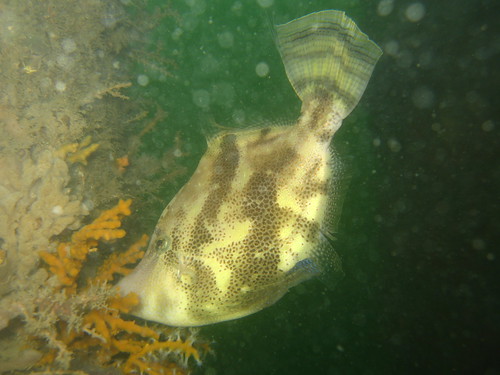



Seagrass filefish or Leatherjackets are generally calm and easy to photograph especially when they are busy feeding. They are capable of manipulating their pigment cells and can almost disappear into the water. You’d have to see it to believe it. When they are calm like this individual is, their patterns, either in the form of spots, stripes or even “hairy” appendage, can be seen. They are also known to be curious and can follow divers for several minutes!
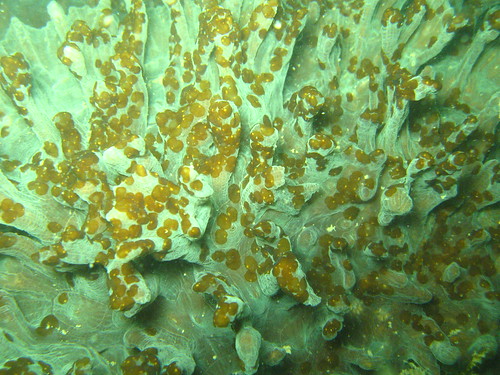




In recent months, these tiny acoel flatworms have been seen to be encroaching upon all species of coral including the free living mushroom coral. These worms don’t parasite on the coral but can cause it damage by blocking out the sunlight the coral needs to produce foods. I’m keen to learn if anyone might know about what allows these worms to flourish and what are the effects if any of their presence on the reef. Please email me if you have any comments about this. Apart from these flatworms, over the past 2 months we’ve observed a significant increase in the presence of jellyfish. At least 3 species of jellyfish seem to be a part of this seemingly sudden population explosion. Jellyfish move with the currents and they also seem to favour warmer waters. What could be the reason for their abrupt influx? A sudden number of jellyfish has also been reported in Malaysian waters on the South China Sea.
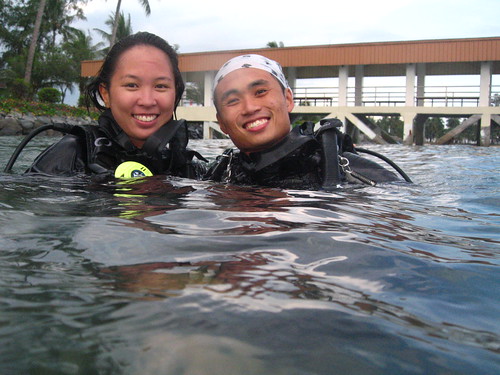
Today was also a last dive for some of the Blog’s fave volounteers Ming Sheng and Marco. After helping Singapore raise the awareness of local marine fauna through the Blog as well as through their own efforts with various volunteer organisations such as Reef Check, Reef Friends, Reef Xplore and Blue Water Volunteers, the 2 are off to various parts of the world to continue their work in an effort to give Mother Nature a break. The Blog applauds the commitment of its volunteers and recognises their invaluable efforts in awareness building, education, leadership and citizenry. By the way, neither Ming Sheng nor Marcel are Singaporean. What gifts they are to the global volunteer network!
 Posted in Blog Log
Posted in Blog Log  No Comments »
No Comments »
 May 16, 2008
May 16, 2008
Paul Hawken is an environmentalist, entrepreneur, journalist, and author. Starting at age 20, he dedicated his life to sustainability and changing the relationship between business and the environment. His practice has included starting and running ecological businesses, writing and teaching about the impact of commerce on living systems, and consulting with governments and corporations on economic development, industrial ecology, and environmental policy.
In this speech at the Bioneers Conference, Hawken delivers an inspiring presentation about the worlds largest movement – the hundreds of thousands of grassroots organizations that address social and environmental justice. The movement that you and I are a part of.
 Posted in Seminars, Videos
Posted in Seminars, Videos  No Comments »
No Comments »
 May 6, 2008
May 6, 2008
Tuesday, 6th May 2008
Seagrasses: Not just for Dugongs!
Siti Maryam Yaakub
11am, Function Hall, Botany Centre, Singapore Botanic Gardens
Mention ‘Seagrass’ and most people think: Food for dugongs! Seagrasses have long lived in the shadow of other more charismatic marine habitats like coral reefs and mangroves. But did you know that Singapore is home to extensive seagrass meadows and more than half the species of seagrasses found in the Indo-Pacific? Learn more about the role seagrasses play beyond that of ‘dugong food’. Join Siti for an insight into what seagrasses are really about and the wacky people who have embraced these green wonders of the ocean.
About the speaker: Siti Maryam is a Senior Biodiversity Officer with the Biodiversity Centre of NParks. She is a marine biologist by training and was one of the co-founders of TeamSeagrass, a volunteer group that monitors the health and status of Singapore’s seagrasses. When she is not counting seagrass, Siti enjoys reading, tennis, experimental cooking and swimming with fish.
Saturday, 10th May 2008
The status and biology the Singapore Freshwater Crab, Johora singaporensis
Sivasothi N
2pm, Function Hall, Botany Centre, Singapore Botanic Gardens
True freshwater crabs have evolved to be completely independent of the marine environment and possess unique characteristics as a result. Many large freshwater streams are home to endemic species and Singapore Island is no exception. The freshwater crab diversity here has been well reported as a result of Peter Ng’s studies in the 1980’s. One crab in particular, was especially celebrated – the endemic Singapore Freshwater Crab, Johora singaporensis. Since that taxonomic examination, little else has been revealed about the crab, partly due to concerns about impacting the small but endangered population. In a recent study, aspects of the population biology, distribution and status of J. singaporensis were studied. This talk discusses the historical discovery, reports highlights of the recent study and discusses conservation implications for the future.
N. Sivasothi is an instructor at the Department of Biological Science more interested in otters and mangroves but inadvertently spent a lot of time in freshwater and peat swamp habitats in the early 90’s on zoological expeditions with Peter Ng. This recent examination of the freshwater crabs in Singapore by both was due to the supervision demands of honours student Daniel Ng.
Tuesday, 13th May 2008
Life – To Give or Not To Give
Karen Teo
11am, Function Hall, Botany Centre, Singapore Botanic Gardens
Acts of compassion turns sour. Come May every year, domesticated animals are illegally released into the nature reserves and reservoirs in the hope of giving them life. But little do many realised that 90% of these domesticated animals end up tragically dead. In an urbanised society like Singapore, the existence of our native flora and fauna hang on a very thin thread. What can we do, as inhabitants of this planet, to save the extensive biodiversity that Mother Earth has so lovingly nurtured over millions of years?
Karen Teo works as a Senior Outreach Officer in Central Nature Reserve, National Parks Board. As an ex-teacher, she is passionate in nature conservation and marrying her teaching skills to share with all the importance of protecting what little natural heritage we have left, through talks, exhibitions, workshops etc.
Saturday, 17th May 2008
Mad About Moths for Kids
Cicada Tree Eco-Place
2pm, Tanglin Core Information Counter, Singapore Botanic Gardens
*This interactive session is limited to 30 children. Please RSVP to lim_wei_ling@nparks.gov.sg by 9th May 2008.
Cicada Tree Eco-Place will conduct Mad About Moths for Kids to share its fascination with our less-known friends, moths. We will offer two concurrent 1.5 hour sessions on moths called Mad about Moths—one for adults and one for kids.
Mad about Moths for Kids will teach kids aged between 5 and 9 how to recognize moths, the differences between moths and butterflies, the life cycle of a moth, why moths are important members of our living planet, and what we can do to make a difference to moths! Children will also get a chance to take quick walk in the Gardens to see some butterflies so as to learn the major differences between moths and butterflies. This session will be fun and engage a young learner.
Cicada Tree Eco-place is a new non-profit, non-governmental organization that promotes nature, culture and eco-living through environmental education. Founded in Singapore in 2007, and managed by volunteer educators and environmentalists, it is named after a native freshwater swamp plant whose habitat is locally endangered, Ploiarium alternifolium (Cicada Tree or Riang Riang).
Saturday, 17th May 2008
Mad about Moths: Emperor Moths & Friends from SE Asia & the Amazon
Dr Preston Murphy
2pm, Classroom 3, Botany Centre, Singapore Botanic Gardens
Dr Preston Murphy will talk about “Mad about Moths: Emperor Moths & Friends from SE Asia & the Amazon” to highlight the beauty of moths in Asia as well as in South America. This talk, targeted at adult nature lovers, will focus on the diversity of large moths and dispel the myth that all moths are dull in colour and unattractive.
Dr Preston Murphy is former President of Lectret Precision Pte Ltd., Singapore, and continues to consult with the company on communications products. He and his wife Mireille are avid eco-travellers and have been to places as wild as Papua New Guinea to look for the birds of paradise. He is a passionate nature photographer, specialising in moths and butterflies.
 Posted in Events, Seminars
Posted in Events, Seminars  No Comments »
No Comments »
 August 5, 2008
August 5, 2008 











 Posted in
Posted in 






























 content rss
content rss
COMMENTS